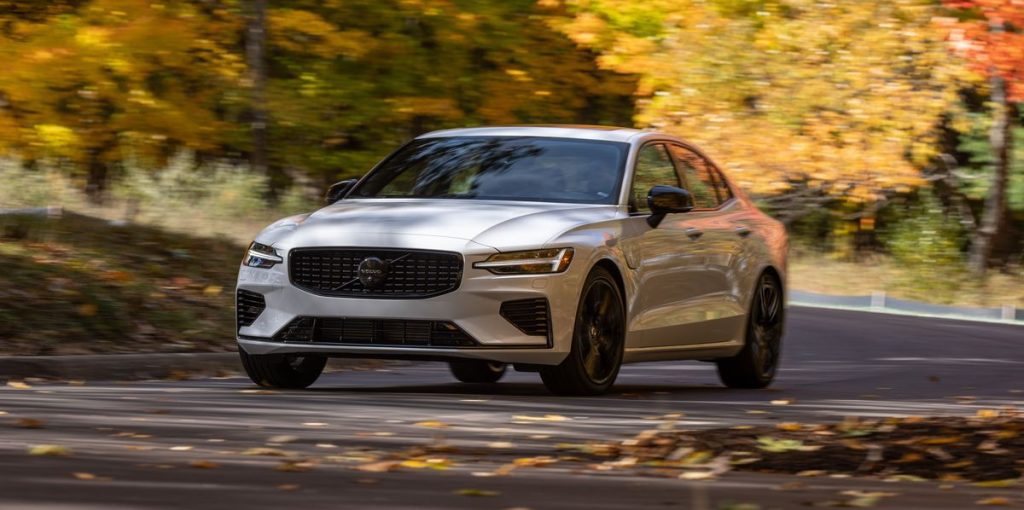Tested: 2023 Volvo S60 Recharge Makes the Leap

Back when mad Maine tuner Ross Converse was dropping Mustang V-8s into Volvo engine bays, it was hilarious to conceive of a Volvo that could hit 60 mph in less than six seconds. Those were cars for Paul Newman and David Letterman, supercharged sleepers with raucous performance that belied their Bar Harbor-antiques-dealer styling. These days, Volvo is its own tuner, as exemplified by the 2023 S60 Recharge. Like Newman’s Converse-modified 960, the S60 is supercharged. Unlike that tuner sled of yore, it’s also turbocharged and electri-charged, by dint of its rear-mounted electric motor. With 312 horsepower from the 2.0-liter inline-four up front and 143 horsepower from the electric motor, the S60 Recharge claims the title of Most Powerful Volvo Ever, packing a combined 455 horsepower and 523 pound-feet of torque. Sure, that title also applies to every other model that offers this powertrain, but a win’s a win.
As complicated as this powertrain is, it proved plenty reliable during our 40,000-mile test of a 2020 model, with modest service costs too. That car, which made 400 horsepower, hit 60 mph in 4.3 seconds. This one, with its additional muscle, knocks a couple of ticks off that time, reaching 60 in 4.1 seconds and dispatching the quarter-mile in 12.5 seconds at 112 mph. That quarter-mile time would be quicker if the S60 didn’t approach its stingy 114-mph speed limiter during the run, causing it to start cutting power at around 110 mph.
Highs: Hits 60 mph in 4.1 seconds, usable EV range and power, reasonable base price.
That conflict—sports-car acceleration pitted against a party-pooper speed limiter—is emblematic of the S60 Recharge’s broader contradictions. On one hand, it seems determined to uphold a safe-and-sane Volvo image, to the extent that there isn’t even a sport mode. But on the other: 455 horsepower and a 60-mph time that’s the same as a reasonably recent 2014 Porsche 911 Targa 4S PDK. Discovering that the respectable, dapper S60 Recharge can smoke Camaros off the line is like discovering that Ned Flanders is ripped. Stupid sexy Flanders.
Besides adding raw power, the upgraded hybrid componentry enables the S60 to work perfectly well as an EV, which wasn’t really the case back when it had 87 electric horsepower. Now, with 143 horsepower and its bigger, 14.9-kWh battery, the S60 could work as a legitimate daily driver in EV mode. Its EPA-rated range is 41 miles, and we saw 34 miles of range during our 75-mph highway test. In traffic, you no longer need to feather the throttle to prevent the gas engine from firing—in fact, if you’re on the throttle during a 90-degree turn across an intersection, you may well hear a tormented howl from the inside rear tire. (In EV mode, the S60 Recharge is rear-wheel drive.)
The S60’s instrument panel includes a display that lets you know how close you are to firing the gas engine, with a pictograph of a drop of fuel (or perhaps a teardrop) representing the point when you enter hybrid mode. It’s easy enough to stay below that line, but if you do invoke hybrid mode, the Recharge is still admirably thrifty, returning 37 MPGe on our highway fuel-economy test and 28 MPGe overall. As another bonus of the upsized battery, the Recharge is now eligible for the full $7500 federal EV tax credit. Since the plug-in powertrain costs $9950 more than a gas S60, that potential net upcharge of $2450 makes the PHEV seem like a no-brainer option.
Outside of its scalding straight-line performance and thrifty economy, the S60 Recharge posts decent but not superlative numbers. (If you want the S60’s chassis to live up to its horsepower, the Polestar Engineered trim is a $16,800 option over the base Core model and $10,100 more than the Ultimate Black Edition.) Braking from 70 mph required 178 feet, while stopping from 100 mph stretched that number to 359 feet. The Volvo’s brakes were indefatigable, though, exhibiting no fade even after multiple stops from triple digits. The S60’s 0.85 g of skidpad grip might have been higher but was inhibited by the tsk-tsk of the stability-control system. Like a ’69 Chevy Chevelle SS, the S60 Recharge prefers the drag strip to the road course. And like a hybrid Ford Maverick pickup, this sedan is rated to tow 2000 pounds, opening up interesting possibilities involving flyweight travel trailers and glamping.
Lows: Fun-killing electronics, mild-mannered handling, Polestar Engineered costs an extra $16,800.
While the revised powertrain is the headline upgrade, Volvo also updated the S60’s infotainment system, which is now Google-based (including Maps, Assistant, and Play store). And the tested Black Edition—which brings blacked-out trim and wheels and is available only with Onyx Black metallic or Crystal White metallic paint—was new last year. But most of the S60’s changes are under the (still handsome) skin.
Which is probably one reason the S60 hews to a reasonable price, given its style and performance. The S60 Recharge’s base tab is $52,345, so with the $7500 credit, you could end up with a net price of $44,845 for a 455-hp Swedish hauler. Our loaded Ultimate Black Edition, which included niceties such as heated front and rear seats, a heated steering wheel, and a head-up display, cost $62,995. A full $3200 of that was the Bowers & Wilkins sound system, which you might skip if you can live with the standard Harman Kardon system. But Volvo’s Bowers & Wilkins systems are some of the best factory audio setups you can buy, so look at it this way—it’s like you’re spending some of that tax credit on walloping bass and tweeters you’d want to display in your living room.
Essentially, the 2023 S60 Recharge looks just like the earlier cars of this generation, but it’s now radically better at its plug-in mission: Charge it each night and you might only need the gas engine for long trips and stoplight drag races. Most mid-cycle refreshes are cosmetic. This one is transformative.
Specifications
Specifications
2023 Volvo S60 Recharge
Vehicle Type: front-engine, rear-motor, rear/all-wheel-drive, 5-passenger, 4-door sedan
PRICE
Base/As Tested: $52,345/$62,995
Options: Ultimate Black Edition (360 degree camera, heated front seats, head-up display, four-way power lumbar, adaptive cruise control, black grille and badging, metallic paint, Charcoal leather interior), $6700; Bowers & Wilkins stereo system, $3200; Climate package (headlight cleaning system, heated steering wheel and outboard rear seats), $750
POWERTRAIN
supercharged, turbocharged and intercooled DOHC 16-valve 2.0-liter inline-4, 312 hp, 295 lb-ft + AC motor, 143 hp, 228 lb-ft (combined output: 455 hp, 523 lb-ft; 14.9-kWh lithium-ion battery pack; 3.7-kW onboard charger)
Transmissions: 8-speed automatic/direct-drive
CHASSIS
Suspension, F/R: control arms/multilink
Brakes, F/R: 14.6-in vented disc/12.6-in vented disc
Tires: Pirelli P Zero All Season
235/40R-19 96V M+S VOL
DIMENSIONS
Wheelbase: 113.1 in
Length: 187.4 in
Width: 72.8 in
Height: 56.3 in
Passenger Volume: 92 ft3
Trunk Volume: 12 ft3
Curb Weight: 4457 lb
C/D TEST RESULTS
60 mph: 4.1 sec
100 mph: 9.9 sec
1/4-Mile: 12.5 sec @ 112 mph
Results above omit 1-ft rollout of 0.2 sec.
Rolling Start, 5–60 mph: 4.5 sec
Top Gear, 30–50 mph: 2.5 sec
Top Gear, 50–70 mph: 3.1 sec
Top Speed (gov ltd): 114 mph
Braking, 70–0 mph: 178 ft
Braking, 100–0 mph: 359 ft
Roadholding, 300-ft Skidpad: 0.85 g
C/D FUEL ECONOMY
Observed: 28 MPGe
75-mph Highway Driving, EV/Hybrid Mode: 69 MPGe/37 mpg
75-mph Highway Range, EV/Hybrid mode: 34/580 mi
EPA FUEL ECONOMY
Combined/City/Highway: 31/30/33 mpg
Combined Gasoline + Electricity: 74 MPGe
EV Range: 41 mi
C/D TESTING EXPLAINED
This content is imported from OpenWeb. You may be able to find the same content in another format, or you may be able to find more information, at their web site.




